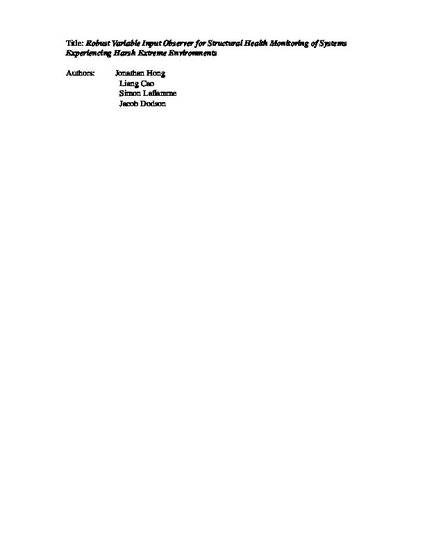
Presentation
Robust Variable Input Observer for Structural Health Monitoring of Systems Experiencing Harsh Extreme Environments
Structural Health Monitoring 2017
Document Type
Conference Proceeding
Disciplines
Conference
The 11th International Workshop on Structural Health Monitoring
Publication Version
Accepted Manuscript
Link to Published Version
https://dx.doi.org/10.12783/shm2017/14162
Publication Date
1-1-2017
DOI
10.12783/shm2017/14162
Conference Date
September 12-14, 2017
Geolocation
(37.42410599999999, -122.1660756)
Abstract
Systems experiencing events in the order of 10μs-10ms timescales, for instance highrate dynamics or harsh extreme environments, may encounter rapid damaging effects. If the structural health of such systems could be accurately estimated in a timely manner, preventative measures could be employed to minimize adverse effects. Previously, a Variable Input Observer (VIO) coupled with a neuro-observer was proposed by the authors as a potential solution in monitoring their structural health. The objective of the VIO is to provide state estimation based on an optimal input space allowed to vary as a function of time. The VIO incorporates the use of mutual information and false nearest neighbors techniques to automatically compute the time delay and embedding dimension at set time intervals. The time delay and embedding dimensions are then used to vary the input space to achieve optimal performance for the estimator based on the observed measurements from sensors. Here, we augment the VIO with a smooth transitioning technique to provide enhanced robustness. The performance of the algorithm is investigated using experimental data obtained from a complex engineering system experiencing a harsh extreme environment. Results show that the enhanced VIO incorporating a smooth transitioning input space outperforms the previous VIO strategies which allowed rapid input space adaptation.
Rights
Works produced by employees of the U.S. Government as part of their official duties are not copyrighted within the U.S. The content of this document is not copyrighted.
Language
en
File Format
application/pdf
Citation Information
Jonathan Hong, Liang Cao, Simon Laflamme and Jacob Dodson. "Robust Variable Input Observer for Structural Health Monitoring of Systems Experiencing Harsh Extreme Environments" Stanford, CAStructural Health Monitoring 2017 (2017) Available at: http://works.bepress.com/simon_laflamme/72/

This is a manuscript of a proceeding published as Hong, Jonathan, Liang Cao, Simon Laflamme, and Jacob Dodson. "Robust Variable Input Observer for Structural Health Monitoring of Systems Experiencing Harsh Extreme Environments." The 11th International Workshop on Structural Health Monitoring (IWSHM), September 12-15, 2017. In Fu-Kuo Chang and Fotis Kopsaftopoulos (eds.) Structural Health Monitoring 2017 (2017). DOI: 10.12783/shm2017/14162. Posted with permission.